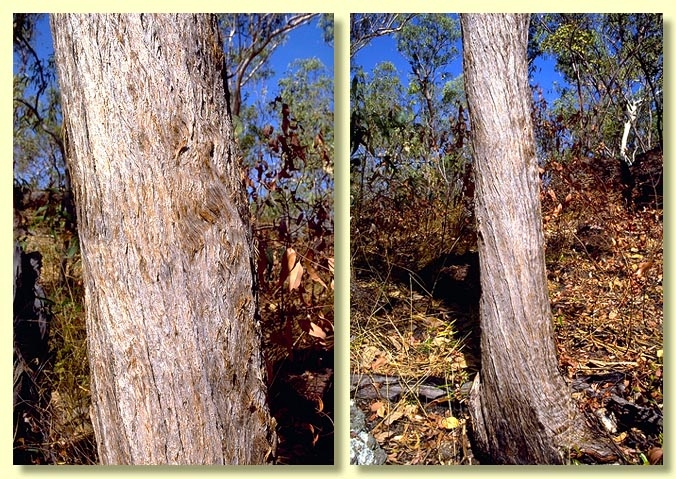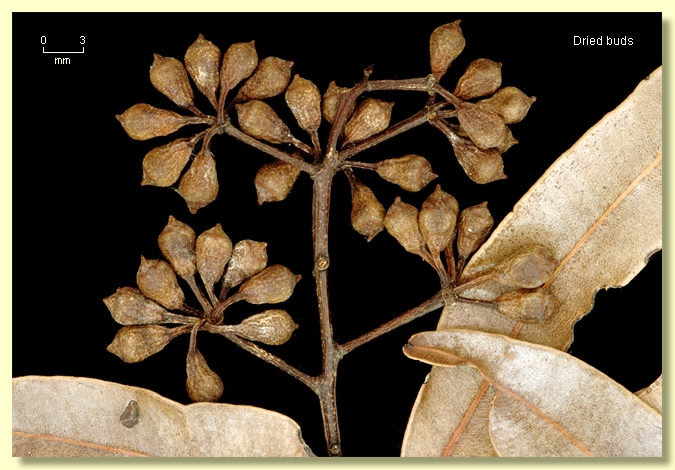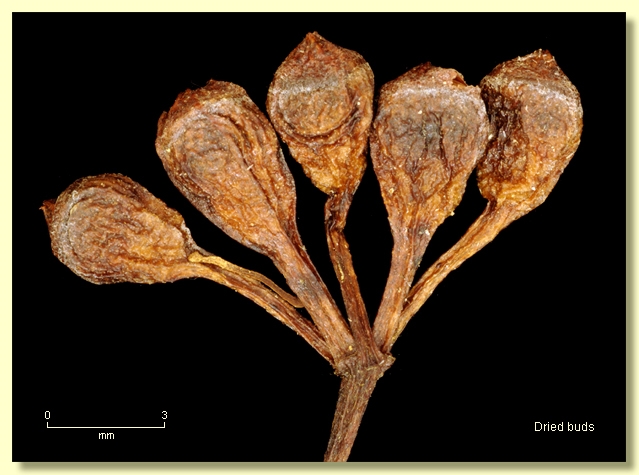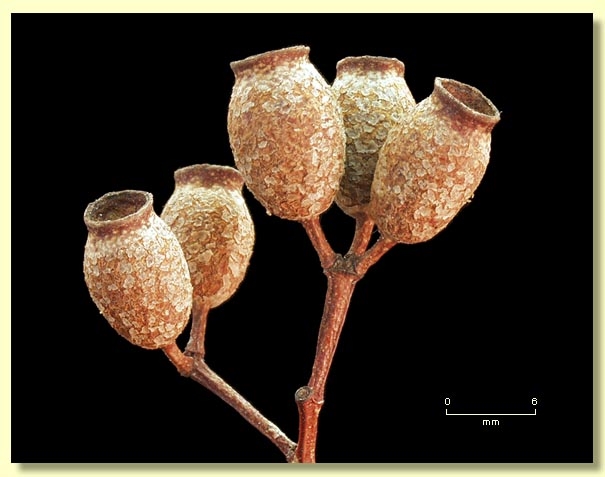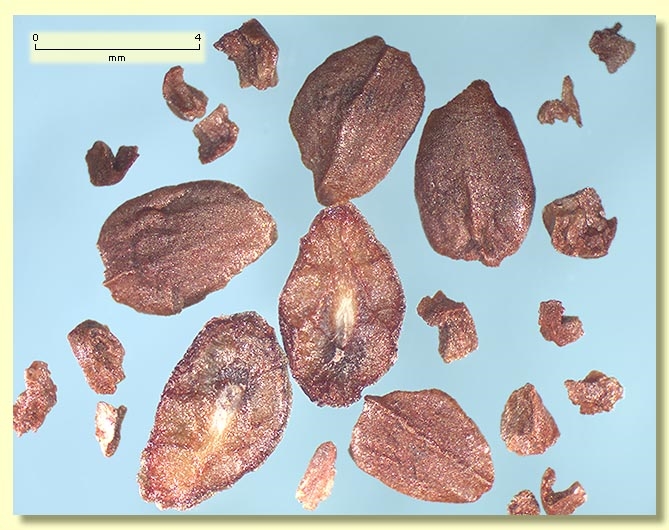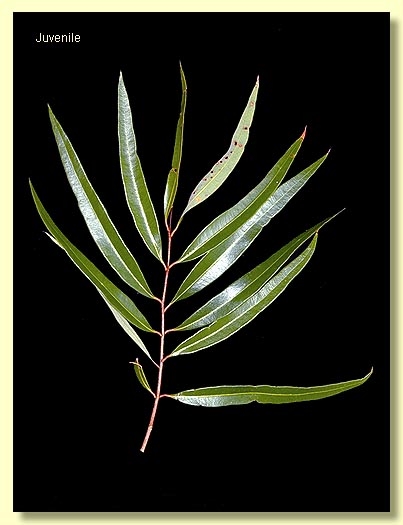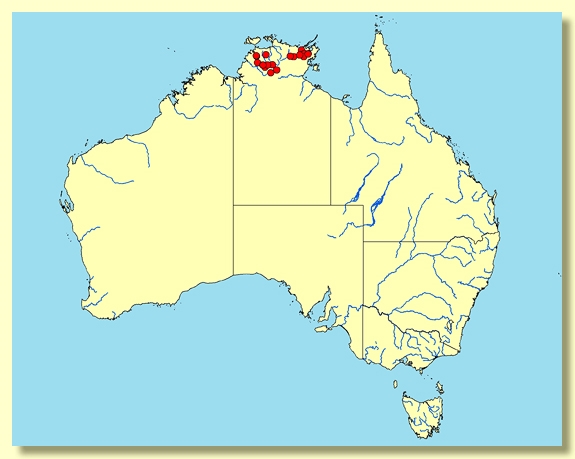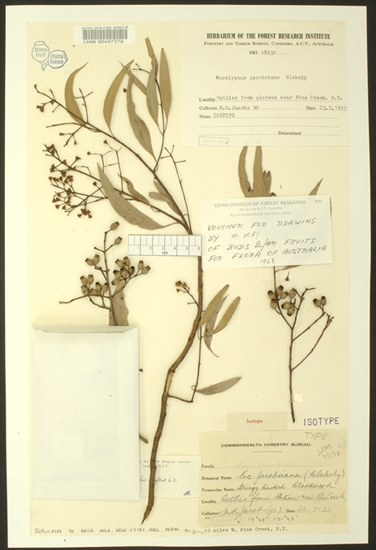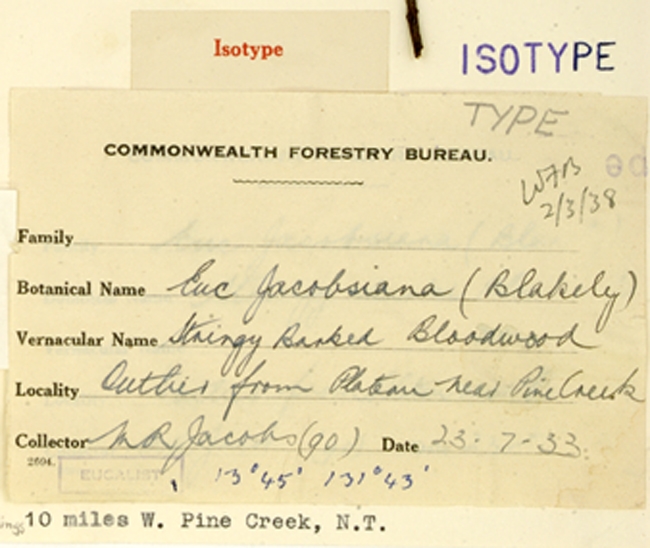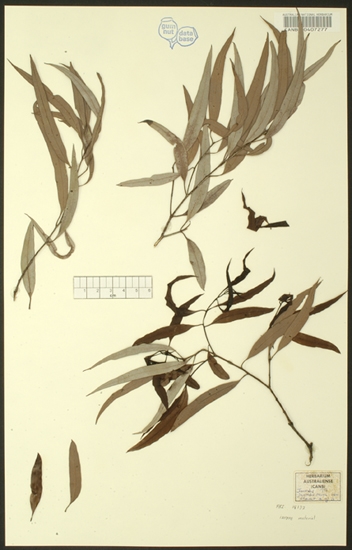Euclid - Online edition
Corymbia jacobsiana
Corymbia | Fundoria
Corymbia jacobsiana(Blakely) K.D.Hill & L.A.S.Johnson, Telopea 6: 225 (1995).
Tree to 20 m tall. Forming a lignotuber and rhizomes.
Bark rough and stringy (long-fibred) to small branches, pale grey and yellow-grey over creamy yellow (not tessellated).
Branchlets lack oil glands in the pith; smooth.
Juvenile growth (coppice or field seedlings to 50 cm): stems rounded in cross-section, setose to scabrid with bristle-glands for many nodes; juvenile leaves always very shortly petiolate, opposite for at least 25 nodes, linear, 4.5–10.5 cm long, 0.2–0.8 cm wide, base tapering to petiole, apex pointed, margins entire, recurved, very glossy, dark green above and glabrous, the underside paler and with sparse setae predominantly on main veins and densely carpeted with short simple white hairs.
Adult leaves alternate, petioles 0.4–2.3 cm long; blade lanceolate to elliptical or falcate, 5.3–13.7 cm long, 0.7–2(3) cm wide, base tapering to petiole, margin entire, apex pointed, strongly discolorous, very glossy and dark green above, much paler below, smooth, side-veins at greater than 45° to midrib, reticulation dense to very dense, intramarginal vein visible but close to margin and more easily seen from underside, oil glands usually present, scattered, island; glabrous.
Inflorescence terminal compound, peduncles rounded to angular, 0.4–1.3 cm long, buds 7 per umbel, pedicels 0.2–0.8 cm long. Mature buds obovoid to pyriform or almost globular, ca 0.4 cm long, ca 0.2 cm wide, smooth, scar absent (both opercula shed together at flowering), operculum rounded and apiculate to conical or shortly beaked, stamens inflexed, all fertile, anthers oblong, dorsifixed, versatile, dehiscing by longitudinal slits, style usually long but dilated in basal third, straight, stigma blunt and long-papillose, locules 3, the placentae each with ca 3 or 4 scarcely distinct ovule rows. Flowers creamy white.
Fruit pedicellate (pedicels 0.2–0.9 cm long), urceolate with an erect neck not or scarcely flared at the rim, or if neck short then fruit ± barrel-shaped, 0.7–1.1 cm long, 0.4–0.8 cm wide, smooth, disc descending vertically, valves 3, enclosed.
Seeds brown, 3–5 mm long, flattened, thin, saucer-shaped to longer than wide, lacking a wing, dorsal surface with a medial shallow keel, hilum ventral.
Cultivated seedlings (measured at ca node 10): cotyledons reniform to orbicular; stems rounded in cross-section, setose with short bristle-glands; leaves sessile or very shortly petiolate (petioles to 0.1 cm), opposite for at least 25 nodes, linear to narrowly elliptical, 4–11.5 cm long, 0.3–1.2 cm wide, base tapering to rounded, margin recurved, apex rounded to pointed, very glossy, dark green above and glabrous, the underside paler and with sparse bristle-glands predominantly on main veins, and densely carpeted with short simple white hairs arising from the epidermis.
Flowering time uncertain ("probably February to April", Brock 1988).
A common bloodwood tree endemic to the monsoonal Top End of the Northern Territory, with a sporadic distribution near Pine Creek, Tipperary and further east in Arnhem Land north-east of Maranboy; found on near level to sloping sites of sandy loam to kaolinitic and rocky substrates. Corymbia jacobsiana is the easiest bloodwood species to identify because it has stringybark over the trunks and branches, crown leaves that are very glossy dark green above and paler below, quite small urceolate to barrel-shaped fruit, and dorsi-ventrally flattened wingless seed; the juvenile leaves are carpeted with simple hairs on the underside. It has no close relatives. MORE ABOUT CORYMBIA
There are only two other rough-barked bloodwood species with fruit of similar size to C. jacobsiana occurring in the Top End of the Northern Territory, C. arnhemensis and C. nesophila. Both these species have tessellated to crumbly rough bark, not long-fibred and stringy as in C. jacobsiana.
UNGROUPED SPECIES IN CORYMBIA
Corymbia jacobsiana: after Maxwell Ralph Jacobs (1905–1979).
Dr Max Jacobs was a distinguished forester, Principal of the Australian Forestry School, Canberra, from 1945 to 1961, and Director-General of the Forestry and Timber Bureau from 1961 until his retirement in 1970. In 1935 he published A Survey of the Genus Eucalyptus in the Northern Territory based on his field studies. In 1955 he published a seminal work in eucalypt silviculture, Growth Habits of the Eucalypts.


